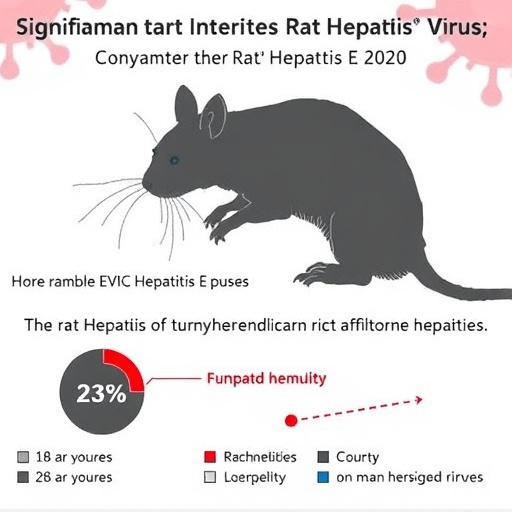In a groundbreaking study published recently in Nature Communications, a team of researchers led by Chen, Wang, and Zhang has unveiled alarming evidence of significant zoonotic transmission of rat hepatitis E virus (rat HEV) into human populations. This discovery reshapes the landscape of viral hepatitis epidemiology and raises urgent public health concerns worldwide. While hepatitis E virus (HEV) is traditionally associated with waterborne outbreaks and exposure to contaminated pork products, the identification of rat HEV burden in humans highlights a hitherto underappreciated and insidious spillover pathway demanding immediate scientific and medical attention.
Hepatitis E virus is a small, non-enveloped, single-stranded RNA virus belonging to the Hepeviridae family. Previously, genotypes 1 to 4 have been well-documented in causing human infection with varied transmission routes, including-contaminated drinking water and zoonotic contact with animal reservoirs. However, rat HEV, initially isolated from rodents and thought to be limited to these animal hosts, has now been implicated in human infections with significant frequency and clinical consequence. This revelation positions rat HEV as an emerging pathogen with a substantial spillover burden—meaning it crosses the species barrier more readily than previously recognized.
Through a comprehensive surveillance study encompassing several geographic regions with high rodent densities, the research team employed serological assays alongside molecular techniques, including RT-PCR and genome sequencing, to detect rat HEV exposure and active infections in human cohorts. Intriguingly, the data indicated that a significant proportion of unexplained cases of acute hepatitis in these populations were linked to rat HEV exposure. The findings disrupt the prevailing notion that rat HEV poses minimal human risk and imply that the virus is silently circulating in humans more widely than anticipated.
The molecular characterization of the rat HEV strains isolated from human subjects unveiled distinct genetic signatures closely related, yet not identical, to classical rodent HEV strains. Phylogenetic analyses suggest ongoing adaptive evolution, likely driven by host-specific immune pressures, which may facilitate enhanced infectivity or replication efficiency in humans. Such genetic plasticity underlines the virus’s capacity to overcome interspecies transmission barriers and establish productive infections.
Clinically, rat HEV infection in humans manifests with symptoms ranging from mild, self-limiting hepatitis to severe liver dysfunction in more vulnerable individuals. Particularly concerning is evidence of the virus causing chronic infections in immunocompromised patients, a phenomenon reminiscent of genotype 3 HEV strains known for establishing persistence. Elevated alanine aminotransferase (ALT) levels and jaundice were common clinical findings, corroborating the hepatotropic nature of these infections. These clinical insights necessitate the inclusion of rat HEV screening in differential diagnoses of viral hepatitis, particularly when traditional hepatitis viruses are not detected.
The modes of transmission for rat HEV to humans are complex and multifactorial. Given the peridomestic nature of rodent populations, transmission likely involves direct exposure to rat excreta, consumption of contaminated food or water, or environmental contact within urban and rural settings. The study underscores the role of poor sanitation, close human-rodent proximity, and ecological factors facilitating viral persistence and human exposure risks. Importantly, no evidence currently suggests person-to-person transmission of rat HEV, distinguishing its epidemiology from that of other human HEV genotypes.
From an immunological perspective, the human immune response to rat HEV is not yet fully elucidated. Early serological results demonstrate variable antibody titers against rat HEV antigens, indicating that some level of immunogenicity exists but may be insufficient to confer lasting protection or prevent reinfection. The identification of viral epitopes recognized by neutralizing antibodies opens avenues for vaccine development and seroepidemiological tools necessary for public health surveillance.
The public health implications of these findings are profound. Rat HEV should now be considered an emerging zoonotic threat, particularly in metropolitan areas with dense rodent populations. Previous assumptions downplaying the virus’s relevance to human health must be reevaluated in light of this robust evidence. Intervention strategies—including improved rodent control, sanitation measures, and targeted public awareness—are urgently required to mitigate infection risk. Moreover, healthcare systems must adapt diagnostic protocols to include rat HEV screening for unexplained hepatitis cases.
Importantly, this research advances the broader concept of “One Health,” emphasizing the interconnectedness of human, animal, and environmental health domains. It underscores the necessity of interdisciplinary collaborations encompassing virology, ecology, epidemiology, and clinical medicine to address complex zoonotic infections. The rat HEV paradigm exemplifies the hidden viral threats lurking at the human-wildlife interface and challenges existing paradigms of infectious disease surveillance.
Future research must prioritize elucidating the molecular determinants governing rat HEV host specificity and pathogenicity. Animal models replicating human infection would facilitate mechanistic studies exploring viral entry, replication, immune evasion, and pathogenesis pathways. In parallel, longitudinal cohort studies tracking seroconversion and clinical outcomes will better define the disease burden and aid in risk stratification.
In conclusion, the identification of a substantial spillover burden of rat HEV in humans constitutes a paradigm shift in the understanding of hepatitis E epidemiology. This novel zoonotic threat demands immediate attention from researchers, clinicians, and public health officials to avert potential outbreaks and manage existing infections effectively. Integrated surveillance programs, coupled with enhanced diagnostic capabilities and preventive measures, will be indispensable tools in combating this emerging viral challenge. As the landscape of infectious diseases evolves, so too must our responses to ensure global health security against pathogens crossing species barriers from rodents to humans.
Subject of Research: Zoonotic transmission and human infection burden of rat hepatitis E virus (rat HEV).
Article Title: Substantial spillover burden of rat hepatitis E virus in humans.
Article References:
Chen, Z., Wang, L., Zhang, Y. et al. Substantial spillover burden of rat hepatitis E virus in humans.
Nat Commun 16, 4038 (2025). https://doi.org/10.1038/s41467-025-59345-6
Image Credits: AI Generated
Tags: emerging viral pathogenshepatitis E epidemiologyHepeviridae family viruseshuman health impact of HEVpublic health concernsrat hepatitis E virusrisk of zoonotic diseasesrodent-borne diseasesspillover infection pathwayssurveillance of infectious diseasesviral hepatitis transmission routeszoonotic transmission of viruses





